
Shear, Harold E., Adm., USN (Ret.)
(1918–1999)
Since his father died before he was born, Shear was raised in the 1920s and 1930s largely by his stepfather, the skipper of a menhaden fishing ship. The youngster thus developed an early love for the sea. He graduated the Naval Academy shortly after the Japanese attack on Pearl Harbor, then served in both the Atlantic and Pacific on board the destroyer USS Stack (DD-406).
Following submarine school in the early months of 1944, he served to the end of the war in the USS Sawfish (SS-276). Postwar duty was at the Submarine Administrative Command, San Francisco, as executive officer of the USS Becuna (SS-319), on the staff of ComSubPac, and in the Bureau of Naval Personnel. In the early 1950s he was executive officer under skipper Ned Beach in the new fast attack submarine USS Trigger (SS-564). Subsequently Shear commanded the Becuna, was a student at the Armed Forces Staff College, participated in a 1956 nuclear weapons war game while serving in the Strategic Plans Division (OP-60) of OpNav, and was a member of the staff of Commander Submarine Squadron Two.
He underwent training for the Navy's nuclear power program in preparation for serving as first blue crew CO of the ballistic missile submarine USS Patrick Henry (SSBN-599). He later had Polaris duty on the CinCLant staff, studied at the National War College, and commanded the fast combat support ship USS Sacramento (AOE-1). As a flag officer, he chief of the U.S. naval mission in Brazil, Director of the Submarine Warfare Division (OP-31) in OpNav, Director, Antisubmarine Warfare and Tactical Electromagnetic Programs (OP-095), Commander in Chief U.S. Naval Forces Europe, Vice Chief of Naval Operations, and NATO Commander in Chief Allied Forces Southern Europe.
After his retirement from active duty in 1980 he worked in the civilian maritime industry and served from 1981 to 1985, during the Reagan Administration, as civilian administrator of the U.S. Maritime Administration.
About this Volume
Based on three interviews conducted by Paul Stillwell from September 1992 through June 1993. The volume contains 385 pages of interview transcript plus an index. The transcript is copyright 1997 by the U.S. Naval Institute; the interviewee has placed no restrictions on its use.



